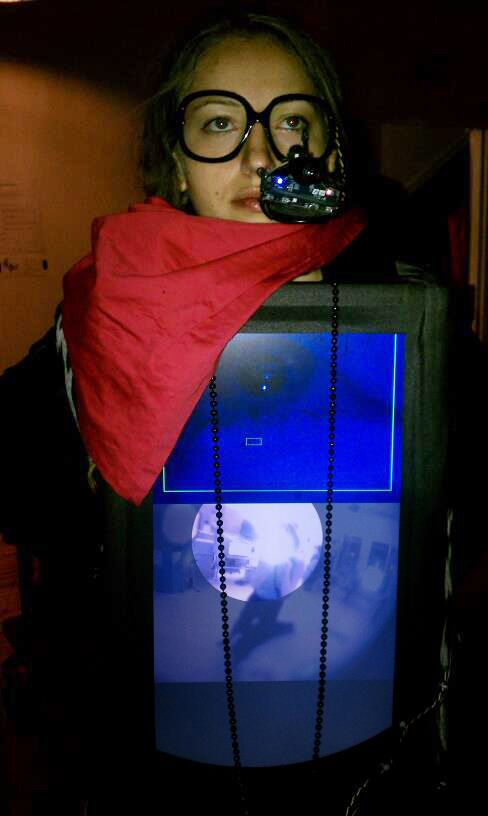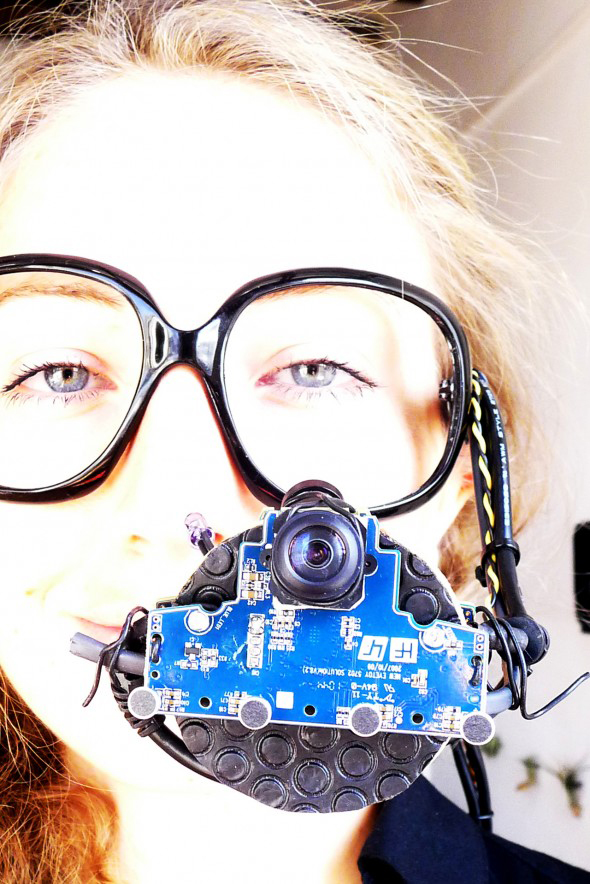
The Gesticulator - A tool for overtly engaging the power of the eyes.
The Gesticulator projects what I am looking at onto my front, turning the gestures of my eyes from a passive to an active, even aggressive, statement.
More so than the gestures themselves, it is the shared awareness (between me and others) of the overtness of my eye movements, their visual representation, and potential archive, that renders common gestures extreme.
Whether being passive, assertive, passive-aggressive, thoughtful, or somewhere in between, you probably employ the power of body language and eye contact. But the unspoken rules that govern the subtle forms of eye communication are difficult to teach. Like language, these rules vary throughout cultures, and depend on one's view of themselves.
The uncrossable divide between the known and felt, between the stated, and the understood, is expressed and perceived in many ways. There seems to be a level of appropriateness and formality to overt verbal communication, that eludes the kind of things we can say, suggest, or demand with our eyes and bodies.
Some of the gestures we "are allowed: to make with our eyes and bodies (like "screw you for stepping on my foot" or "I am looking at you, up and down, and thinking about making sweet love to you" or "um, you are making me really uncomfortable please back away", or "I am so disinterested in what you are talking about I am trying to escape") are absolutely not appropriate to say out-loud. Yet we are fully accustomed to perceiving them otherwise. Why do we accept them in their less-overt forms? At times, the contrast between the perceived and the acknowledged is so great that it becomes awkward, hilarious, and very interesting.
I was recently in Boston riding the T and a man, sitting in the middle of a bench, was hoarding the surrounding three seats by literally holding onto them with his arms. His head was down all the way to avoid eye contact with the crowd standing directly in front of the empty seats. I was struck by the fact that he was so territorial yet unable to stand up for it with his eyes. If I had verbally asked him to sit down, I wondered, would he deny the statements of his body and allow me to sit? Or would he be able to say out-loud what he was already clearly communicating? It seemed that by not looking up at us, he was denying us the ability to engage in his non-overt form of communication. He was reserving the unilateral right to "speak", and leaving no room for two-way non-verbal discussion. He was putting us at the very edge of the divide between the two forms of communication: a very precarious position, where one is forced to confront their fears about engagement.
To a lesser degree, I encounter this precarious situation daily during my subway commute, where I use my eyes to kindly ask for some space, or to sternly make somebody aware that they are in the way. Avoiding eye contact shields us from these statements. In this way, eye contact seems to be the bridge to acknowledging body language and behavior.
The train is a breeding ground for these moments. We do not speak to each other, yet crowd into a small spaces. We use exclusively gesture and eye contact to communicate.
Sometimes non-verbal statements seem to creep toward the "overt layer," like when two people are aware that they are both aware of it, and yet maintain a distance between the spoken and physical in their conversation. It can be ignored as people see fit: it is essentially passive. As a result, it can be frustrating.
There is an entire blog dedicated to inappropriate subway behavior that speaks to this frustration: http://www.subwaydouchery.com/page/25
I found the blog while looking for a good illustration of this awkward moment where making eye contact threatens to bring your behavior into the realm of the addressable, the acknowledgeable, and maybe even the spoken. This thought is not mine alone, because I found this post:
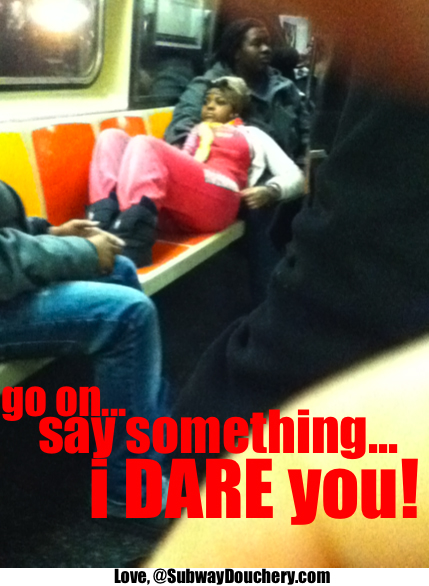
Gaze, direction, focus, and glances, can be powerful and tools. I use the periphery of my vision as intentionally as I use my direct glance. Today I was walking down the street when a man started to walk toward me very quickly from the side. Instead of looking directly at him, I looked in his direction, but specifically at somebody else more slightly to my left, so as to hold him in my periphery. I immediately wondered where this controlled and intentional reaction came from. My instinct was to turn my head immediately in fear of approaching danger, but just as instantly something inside of me gave me pause and, with the ease of somebody expert at such gestures, I widened my vision and changed the intention of my gaze.
Perhaps direct gaze is more communicative and therefore more acknowledgeable, and maybe I did not want to expose my fear. Whatever the reason, it seemed to be learned and personal.
These rules, personal or cultural, that define the divide between the stated and the non-overt, define our engagement with each other. We use our eyes to mediate these rules.
This project is about our personal struggles with a social contract that creates hilarious, awkward, and sometimes difficult situations.
Would amplifying it visually, making it undeniable, make it less passive? How would I deal with the power of non passive body language? What if I were subjected to the same level of scrutiny in regards to my bodily statements as I feel toward my words?
The Gesticulator projects what I am looking at onto my front, turning the gestures of my eyes from a passive to an active, even aggressive, statement. More so than the gestures themselves, it is the shared awareness (between me and others) of the overtness of my eye movements, their visual representation, and potential archive, that renders the common gestures extreme.
Is objectifying the gestures the key to bridging the gap between the unspoken and passive and the spoken, active, and intentional?

This project was built with the help of the open source eyewriter project.
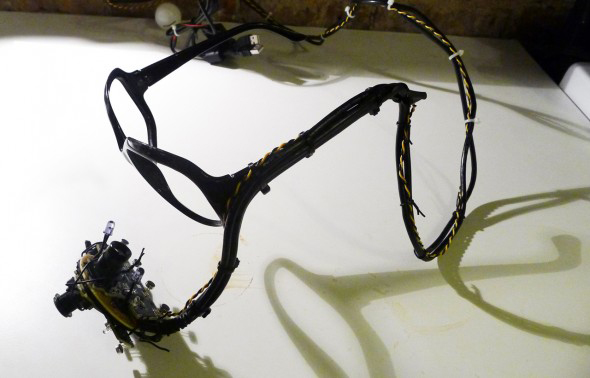
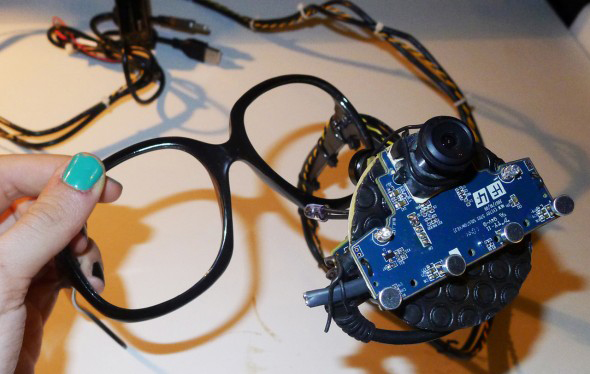
The eyewriter project's instructions are available online, and helped me figure out how to hack a ps3 Eye camera to include an IR filter. In addition to their system, I added an externally-facing camera with a wide angle lens to capture the field of vision. I adapted a code given to me by Dan O'Sullivan that uses the java rectangle class to find the pupil based on its size, and its relationship to the glint, a reflection of an infrared LED pointed at the eye.
The code analyzes the field of vision to find the eye's view based on the position of the pupil. This is done by first calibrating the glasses to the extreme locations of the pupil, and mapping that onto the field of vision.
My first attempts were surprisingly successful. In the following video, one clip shows my eyeball movement, and the next what my program thinks I am looking at. Because I could not look at something while also looking at my computer to check for accuracy, I typed what I was looking at, and checked the video for accuracy afterward, and for the most part it was accurate!
In terms of my idea to wear what I am looking at, it is kind of ironic (or perfect?) that my camera apparatus is covering up my mouth. I had intended to make it as low profile as possible, and at the moment this is the best I could do :)

